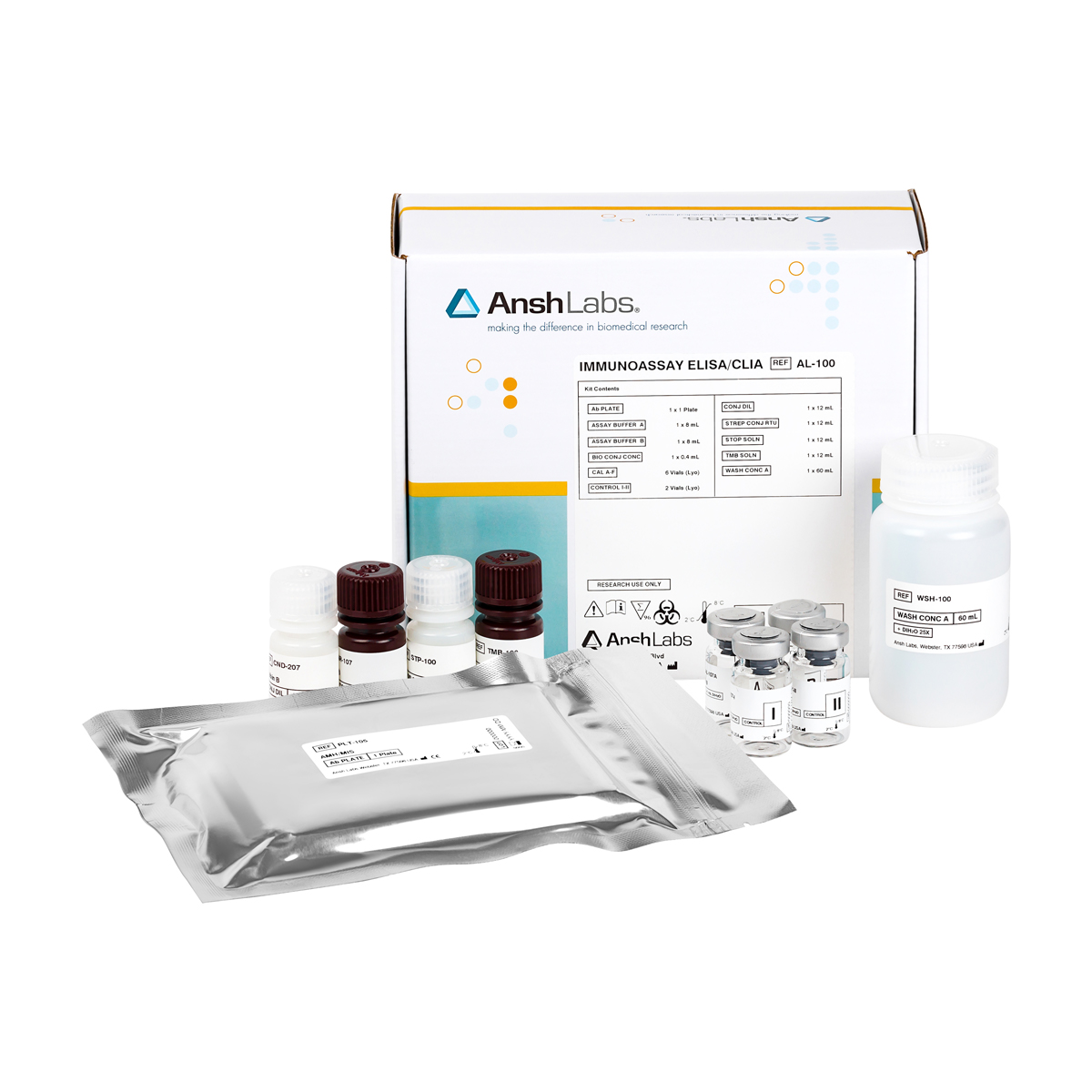The Mouse PAPP-A enzyme linked immunosorbent assay (ELISA) kit provides materials for the quantitative measurement of PAPP-A in mouse serum, cell supernatant, and other biological fluids.
| Catalog Number | |
|---|---|
| Packaging | 96 well microtiter |
| Detection | HRP-based ELISA, colorimetric detection by dual wavelength absorbance at 450 nm and 630 nm as reference filter |
| Dynamic Range | 6, 0.24-10.3 ng/mL |
| Limit of Detection | 0.020 ng/mL |
| Sample Size | 25 µL |
| Sample Type | Serum, Cell Culture Supernatant |
| Assay Time | 3.5 hours |
| Species Reactivity | Bovine Serum, Canine Serum, Caprine Serum, Equine Serum, Feline Serum, Murine Serum, Ovine Serum, Porcine Serum, Squirrel Monkey Serum, Vervet Monkey Serum |
| Shelf Life | 24 months |
| Availability | Worldwide |
Pregnancy-associated plasma protein-A (PAPP-A) is a novel zinc metalloproteinase that functions in many systems outside of pregnancy. PAPP-A expression has been reported in various tissues, including endometrium, testis, kidney, bone, colon, and other adult and fetal tissues.1-12 Abundant PAPP-A mRNA expression levels were found in visceral fat and these were 10-fold higher than in subcutaneous fat.10 PAPP-A expression significantly increases with age in kidney, brain and gonads10 and significantly deceases with age in bone and skeletal muscle.10 In the thymus, PAPP-A mRNA showed a biphasic response with age.10 Data in both humans and mice suggest a role for PAPP-A in aging and age-related diseases.10 Expression of IGFBP-5 mRNA, a marker of insulin-like growth factor-I (IGF-I) bioactivity known to be regulated by PAPP-A, paralleled the changes in PAPP-A expression with age in kidney, bone, skeletal muscle and thymus. PAPP-A is potentially proatherosclerotic and has been proposed as a new marker of inflammation, as high serum PAPP-A levels are observed in patients with renal impairment, asthma, lung cancer, etc.1-12 Stimulation of PAPP-A expression by intermittent PTH treatment contributes to PTH bone anabolism in mice.9 Effect of PAPP-A on tendon structure and mechanical properties have been studied8, However, quantitative determination of PAPP-A in mouse tissues with age are limited due to unavailability of the mouse PAPP-A ELISA.
References:
1. Bulut I, Coskun A, Ciftci A et al. Relationship between Pregnancy associated plasma protein A and lung cancer. The American Journal of the Medical sciences. April 2009; 337 (4): 241-244
2. Schindler AM, Bischof B. Histochemical localization of pregnancy associated plasma protein-A in fetal, infant, and adult organs and camparison between antisera. Gynecol Obstet Invest. 1984; 18: 88-94.
3. Overgaard MT, Oxvig C, Christiansen M , et al. Messenger ribonucleic acid levels of pregnancy-associated plasma protein-A and the preform of eosinophil major basic protein: expression in human reproductive and nonreproductive tissue. Biol Reprod 1999; 61:1083-1089.
4. Fialova L, Kalousova M, Soukupova J, et al. Relationship of pregnancy associated plasma protein A to renal function and dialysis modalities. Kidney Blood Press Res. 2004; 27: 88-95.
5. Coskun A, Balbay O, Duran S et al. Pregnancy-associated plasma protein A and asthama. Adv Ther. 2007; 24: 362-367.
6. Coskun A, Duran S, Apaydin S, et al. Pregnancy-associated plasma protein A: evaluation of a new biomarker in renal transplanted patients. Transplant Proc. 2007; 39:3072-3076.
7. Bayes-Genis A, Conover CA, Overgaard MT, et al. Pregnancy-associated plasma protein A as a marker of acute coronary syndromes. N Engl J Med. 2001; 345: 1022-1029.
8. Yang TH, et al. PAPP-A affects tendon structure and mechanical properties. J Struct Biol. Oct 2015; 192(1):59-66.
9. Clifton KB, et al. Pregnancy-associated plasma protein-A modulates the anabolic effects of parathyroid hormone in mouse bone. Bone. Dec 2015; 81:413-6.
10. Harstad SL, et al. Tissue-specific changes in pregnancy associated plasma protein-A expression with age in mice. Endocrinology. Sep 2014; 57:13-7.
11. Bale LK, et al. Inducible reduction in pregnancy-associated plasma protein-A gene expression inhibits established atherosclerotic plaque progression in mice. Endocrinology, Apr 2014; 155(4):1184-7.
12. Conover CA, et al. Preferential impact of pregnancy-associated plasma protein-A deficiency on visceral fat in mice on high-fat diet. Am J Physiol Endocrinol Metab. Nov 2013; 305(9):E1145-53.
13. HHS Publication, 5th ed., 2007. Biosafety in Microbiological and Biomedical Laboratories. Available http://www.cdc.gov/biosafety/publications/bmbl5/BMBL5
14. DHHS (NIOSH) Publication No. 78–127, August 1976. Current Intelligence Bulletin 13 – Explosive Azide Hazard. Available http:// www.cdc.gov/niosh.
15. Approved Guideline – Procedures for the Handling and Processing of Blood Specimens, H18-A3. 2004. Clinical and Laboratory Standards Institute.
16. Kricka L. Interferences in immunoassays – still a threat. Clin Chem 2000; 46: 1037–1038.
